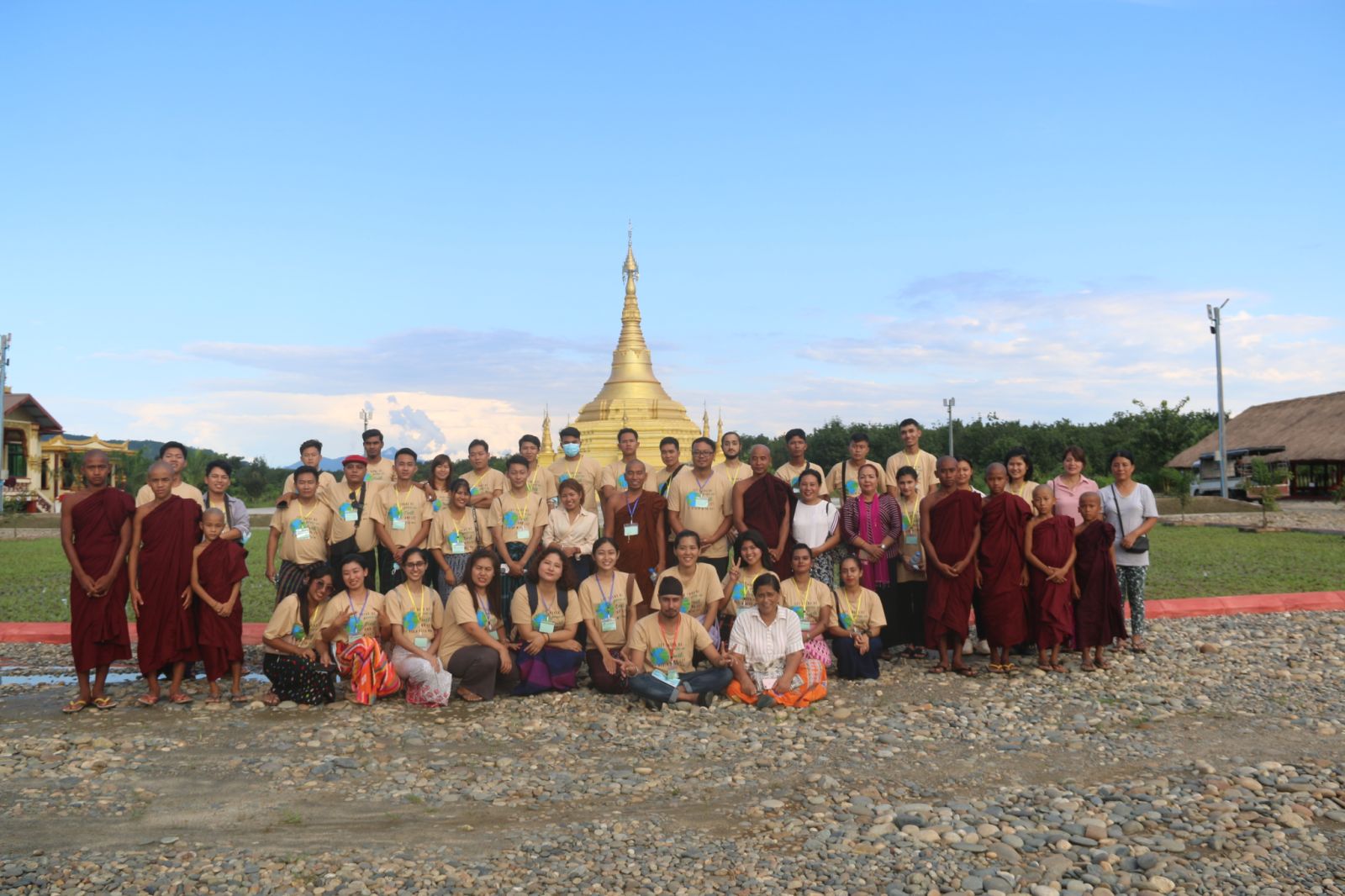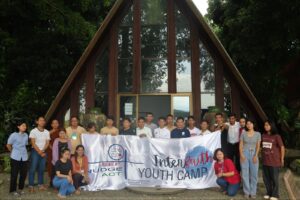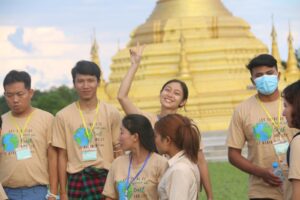
Dialogue is like a dance. It is a movement. In dance we can have unity but also diversity, writes Columban missionary Fr Kurt Zion Pala from Myanmar.
Through dance, we can come together with our different identities but still able to have a conversation through the dance. When we run out of words, we can speak through our bodies.
Manau dance is a dance of diversity and unity. The Kachin peoples, composed of seven different groups, perform the Manau dance for different purposes including to celebrate victory in a war or to mourn a death. Taking its inspiration from the circular movements of animals, legend has it that man learned how to dance from the birds, animals and insects.
 Between 23 – 26 September, 32 young people from five major religions (16 Christians, 5 Muslims, 5 Hindus, 4 Sikhs, and 2 Buddhists) in Myanmar participated in the first Interfaith Youth Camp facilitated by the Catholic Student Action Myitkyina (CSAM).
Between 23 – 26 September, 32 young people from five major religions (16 Christians, 5 Muslims, 5 Hindus, 4 Sikhs, and 2 Buddhists) in Myanmar participated in the first Interfaith Youth Camp facilitated by the Catholic Student Action Myitkyina (CSAM).
 The camp was held at the beautiful Nawng Nang Centre in Myitkyina, Kachin State, Myanmar.
The camp was held at the beautiful Nawng Nang Centre in Myitkyina, Kachin State, Myanmar.
On the last night of our recent interfaith camp, the young people ended the programme with the Manau Dance led by Kachin Christian youths.
Myanmar has been for a long time facing numerous internal conflicts and national crisis. The country is host to the longest ongoing civil war in the world at sixty years plus. With over 135 recognised ethnic groups which call Myanmar home, these cultural differences and identities play an important role in this protracted civil war.[1]
And often to every culture or tribal group is attached a particular religion or spiritual practice which makes religion an important aspect of the ongoing struggle in the country.
 The diversity of the people is also a reflection of the diversity in Myanmar’s natural treasure – its flora and fauna. But the ongoing internal conflicts has intensified the destruction of its natural environment. Given this ongoing reality, the Interfaith Youth Camp was organised under the theme ‘Let there be Peace on Earth. Let it begin with Me.’
The diversity of the people is also a reflection of the diversity in Myanmar’s natural treasure – its flora and fauna. But the ongoing internal conflicts has intensified the destruction of its natural environment. Given this ongoing reality, the Interfaith Youth Camp was organised under the theme ‘Let there be Peace on Earth. Let it begin with Me.’
The camp provided inputs not only on Intereligious Dialogue but also on Mental Health. Many young people are suffering from some form of mental health problems or issues. The experts provided simple and practical suggestions on managing stress and self-care.

They also clarified many facts and myths about mental health. The Interreligious Dialogue session helped the participants understand the definition of true dialogue, the values and different ways of doing dialogue.
The camp also allowed the participants to share about their own religion through a 15-minute presentation bringing along some items or symbols from their religion.
On the last night during the Cultural Show, each group showed off their cultural dances and songs – Indian-inspired dances, Lisu tribal dance, Burmese songs, finishing off with the Kachin Manau dance.

There was also a cultural food exchange on the last night where each group prepared and shared traditional food with everyone. The Muslims prepared samai, a dish of sweet fine vermicelli noodles mixed with warm milk. The Sikhs brought Barfi or burfi, a basic fudge made using full fat milk, sugar and ghee.
The Gurkhas mostly Hindus also brought with them different kinds of Indian sweets. While the Kachin/Lisu Christians prepared traditional “jap htu,” pounded ginger, chillies, dried fish and other spices.
 They also prepared a traditional rice wine called “tsa pi.” As they presented their different dishes, they also explained the meaning and significance of each dish.
They also prepared a traditional rice wine called “tsa pi.” As they presented their different dishes, they also explained the meaning and significance of each dish.
Every morning we also learned different meditation traditions like the Buddhist and Indian Yoga meditation. Meditating or praying together is also a form of dialogue.
The original design of the camp was to have a pilgrimage to the different places of worship – Muslim mosque, Hindu mandir, Sikh gurdwara, Buddhist temple – monastery and Christian churches.
 But the political situation in the country makes it dangerous and difficult to facilitate. So the participants were only able to visit a Buddhist temple-monastery, which is quite near the camp venue.
But the political situation in the country makes it dangerous and difficult to facilitate. So the participants were only able to visit a Buddhist temple-monastery, which is quite near the camp venue.
At the Buddhist monastery, the participants met the head monk and his novices. The headman spoke to the participants encouraging them. Then the participants and the Buddhist monks planted some trees.
 The camp also introduced to the participants the Golden Rule and the Review of Life method (See-Judge-Act). Participants were taught to use the method to look at their present situation. The participants identified climate change related issues like drought, damaged farms, gold mining and other environmental disasters.
The camp also introduced to the participants the Golden Rule and the Review of Life method (See-Judge-Act). Participants were taught to use the method to look at their present situation. The participants identified climate change related issues like drought, damaged farms, gold mining and other environmental disasters.
 They asserted that it is wrong to only look at the economical benefits that the natural environment bring and not their innate value. Greed for profit led to many companies coming to Myanmar to steal its natural resources. People also throw their wastes anywhere and everywhere.
They asserted that it is wrong to only look at the economical benefits that the natural environment bring and not their innate value. Greed for profit led to many companies coming to Myanmar to steal its natural resources. People also throw their wastes anywhere and everywhere.
Through the cultural night and the food exchange we have learned to share faith, food and friendship. These three Fs for me are practical ways to do dialogue. The camp ended with the cultural night where each group was able to present traditional dances.

“We came together from different backgrounds. We were together to form friendship and learn about other faiths for 3 days there. During the camp, we were able to learn about each other and understand each other.”
“I believe that this Interfaith Youth Camp was helpful for all of us because all participants had a chance to understand and respect one another. This camp helped me realize that we are living under the same sun and we interconnected and interdependent even though we have multiple faiths.”
“This kind of youth camp is important for Myanmar, my country because to understand each other is urgently needed in our country. I had funny experience while I was in camp. Some participants did not know what monkhood is. They wanted to offer me dinner so I had to explain that monks do not eat evening meal. But I have not known about Sikhism before this camp. Therefore, this is absolutely vital in our country.”
“I learned many things from attending this Interfaith Youth Camp. I have already known that we have many problems in our community. I learned that right way to solve these conflicts is to understand the origins where they came from. We are from different faith and ethnic group.”
-Ashin Nandasara, a Buddhist Burmese monk joined the camp as a participant and speaker.
[1] Stratton, Larry D., “Burma: Worlds’s Longest Ongoing Civil War-An Exploration of NGO Free Burma Rangers Philosophy and Collective Identity and its Effect on the Ethnic Burmese in Promoting Peace” (2013). Capstone Collection. 2603. https://digitalcollections.sit.edu/capstones/2603
Fr Kurt Zion Pala is from Iligan City, Lanao del Norte in the Philippines. He was ordained a priest in 2015. He spent two years in Fiji while still a seminarian and a year in Malate Parish, Manila. He has been based in Myanmar since 2017.

Support Columbans working in Myanmar by donating online here: https://columbans.ie/donate/ Alternatively, please send your donation to the Far East Office, Dalgan Park, Navan, Co Meath C15 AY2Y or call 00353 46 909 8275